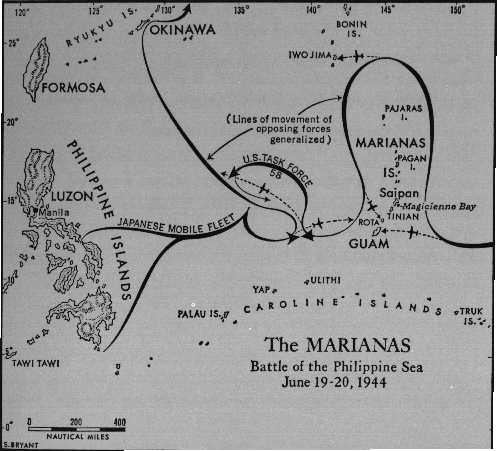Pat McCreery
The U. S. invasion of the Mariana Islands on 15 June 1944 brought the Japanese fleet out fighting for the first time since the naval battles of Guadalcanal in the fall of 1942. Determined to force a showdown battle, Admiral Soemu Toyoda ordered a combined fleet of 9 carriers and 18 battleships and cruisers to attack the U. S. warships protecting the landing on Saipan. Here Admiral Raymond Spruance, Commander of the U. S. Fifth Fleet, organized defensive preparations and sent 15 fast carriers of Task Force 58, commanded by Vice Admiral Marc A. Mitscher, west to intercept the Japanese, then only 90 miles away.
The battle opened early on 19 June with an attack on Task Force 58 by Japanese land-based planes from Guam and Truk. Hellcat fighters from our carriers destroyed 35 enemy fighters and bombers. The remainder of the battle was fought by 430 Japanese carrier planes attacking the 450 planes of Task Force 58 in four fierce waves.
At the end of the eight-hour onslaught, only 100 of the enemy planes returned to their carriers. The rest had been destroyed in the most decisive aerial combat in history. Thirty American planes were lost in what the fliers called the "Marianas Turkey Shoot." No damage was done to the U. S. Fifth Fleet's ships.

On the night of 19 June, the Japanese turned to the northwest and fled with the U. S. carriers in hot pursuit. On the evening of the 20th, Mitscher decided he could get no closer and launched 209 planes. The Japanese were now 300 miles away. This would be to the extreme limit of the fighters' range, plus they would be returning in the dark.
The success of the raid was just so-so. The Japanese carrier HIYO was sunk, but 20 of our planes were shot down and 80 more did not make it back. Of the 80 that went down, 51 pilots were saved. I was a crewmember of USS IRWIN (DD 794), and we picked up one of them.
It was a tricky, sticky thing. Not only were they low on fuel, but in the dark they had to find a carrier. They were coming back not in the formations we were used to seeing, but straggling in groups of two or three. Planes started to go down. Others circled, trying to find their carriers. It was then that Vice Admiral Marc Mitscher gave a four word order that made him the most beloved admiral in the Navy: "Turn on the lights." Immediately, every ship in the fleet turned on its searchlights and pointed the beams skyward. The glow from nearly 200 searchlights could be seen for a hundred miles.
As soon as a pilot knew he was going down, he would pick out a ship and flick his landing lights on and off. When we saw one of them coming, the crew on the port side searchlight depressed the beam to the water. The pilot could now judge how much elevation he had, and we on the ship could keep his plane in sight .... In he went.
Chief Boatswain Mate Jorgensen commanded the whaleboat and was alongside the plane, which was still afloat, in less than two minutes. The pilot was standing in the cockpit and jumped in when the boat came alongside. A crash landing at sea, and he didn't even get his feet wet!
Supper was late that night. Somehow those remarkable men in the galley stirred up a small cake, lit a candle, took it to the Officers' Mess and presented it to the young flier. It was his 22nd birthday.